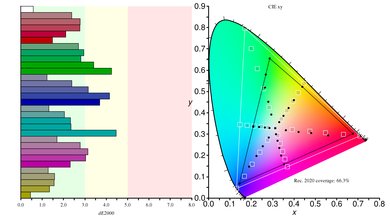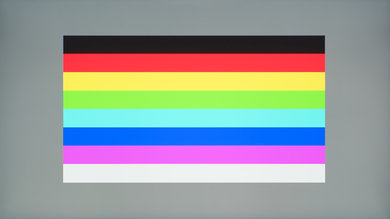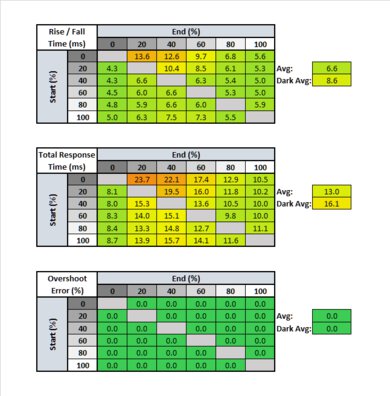The Gigabyte AORUS AD27QD is a great 1440p, 144Hz gaming monitor. It has a great design, with RGB bias lighting, good ergonomics, and an easy-to-remove stand. It delivers good overall picture quality, but like most IPS monitors, it doesn't look as good in a dark room due to its low contrast ratio. This monitor has outstanding motion handling with very fast response time, a black frame insertion feature, and low input lag. Finally, it has a unique set of additional features that could give some gamers that extra little edge, including a unique active noise cancellation feature.
Our Verdict
The Gigabyte AORUS AD27QD is a good monitor for most uses. It has wide viewing angles, good ergonomics, and great peak brightness. Gamers will appreciate the fast response time, FreeSync support, low input lag, and an impressive array of additional features to enhance your gaming experience. Unfortunately, it has a low contrast ratio and terrible black uniformity, but it has excellent out-of-box color accuracy.
- Great gaming features.
- Image remains accurate when viewed at an angle.
- Impressive additional features to enhance experience.
- Mediocre dark room performance.
The Gigabyte AORUS AD27QD is a good office monitor. The 27 inch, 1440p screen offers plenty of space to open multiple windows at once, and the good ergonomics allow you to place the monitor how you like. It has great horizontal viewing angles for when you need to share your screen with others, but the vertical viewing angles are just decent, which is only a problem if someone's looking down at the monitor.
Great gaming monitor. The 144Hz Gigabyte AORUS AD27QD supports FreeSync variable refresh rate technology to reduce screen tearing, and it's compatible with newer NVIDIA graphics cards. The input lag is incredibly low and the quick response time produces clear motion. Unfortunately, it doesn't perform well in dark rooms due to its low contrast ratio, but it has great viewing angles.
Good monitor for multimedia. The image remains accurate when viewed at an angle, which is great for sharing the latest trends with a group of friends. The fast response time delivers clear motion, with very little blur. Unfortunately, the Gigabyte AORUS AD27QD isn't as well-suited for watching videos in a dark room though, as it has a mediocre contrast ratio and terrible black uniformity.
The Gigabyte AORUS AD27QD is good for media creation. It has an excellent SDR color gamut and great coverage of the wider Adobe RGB color space. The 27 inch screen and 1440p resolution allow you to see more of your work at once, so you spend less time scrolling around or zooming. Unfortunately, it has some color bleed that could cause issues for photo editing, but it has excellent out-of-box color accuracy.
The Gigabyte AORUS AD27QD is a decent monitor for HDR gaming. It has decent peak brightness in HDR, but small highlights in some scenes aren't as bright as they should be. It can display a wide color gamut, which is great, but it's limiting and doesn't add much to HDR. Unfortunately, it has a mediocre contrast ratio, terrible black uniformity, and there's no local dimming feature to further darken any blacks.
Changelog
- Updated Aug 28, 2020: Retested VRR input lag.
- Updated Aug 05, 2020: We rechecked our pre-calibration results, but no changes were necessary.
- Updated Feb 17, 2020: Converted to Test Bench 1.1.
- Updated Jul 12, 2019: The HDR input lag was erroneously tested at 144Hz, with 8-bit color. We have retested it at 120Hz with 10-bit color, and updated the review.
Check Price
Differences Between Sizes And Variants
We tested the 27 inch Gigabyte AORUS AD27QD, which is the only size available. Gigabyte produces a few other monitors, which you can see below.
| Model | Size | Panel | Resolution | Refresh Rate | Notes |
| AD27QD | 27" | IPS | 2560x1440 | 144 Hz | |
| CV27Q | 27" | VA | 2560x1440 | 165Hz | Supports DisplayPort 1.4 |
| CV27F | 27" | VA | 2560x1440 | 165Hz | |
| FI27Q | 27" | IPS | 2560x1440 | 165Hz | |
| FI27Q-P | 27" | IPS | 2560x1440 | 165Hz | Supports DisplayPort 1.4 |
| KD25F | 25" | TN | 1080p | 249Hz |
If someone comes across a different type of panel or if their Gigabyte AORUS AD27QD doesn't correspond to our review, let us know and we will update the review. Note that some tests, such as the gray uniformity, may vary between individual units.
The AD27QD we reviewed was manufactured in December 2018, and you can see the label here.
Popular Monitor Comparisons

The Gigabyte AORUS AD27QD is a great gaming monitor at an aggressive price and has some impressive additional features. See our recommendations for the best gaming monitors, the best 1440p 144Hz monitors, and the best 1440p gaming monitors.
The Gigabyte AORUS AD27QD is a bit better than the Acer Nitro VG271UP Pbmiipx. The AORUS has much better ergonomics, so it's easier to place it in an ideal viewing position. The AORUS also has many more additional features, including a unique active noise cancelling feature.
The LG 27GN850-B/27GN880-B and the Gigabyte AORUS AD27QD are two very similar monitors. The LG is slightly better for gaming because it has a quicker response time at its max refresh rate and 60Hz. However, the Gigabyte is better for office use because it has improved ergonomics and it gets brighter, so it's a better choice for well-lit rooms.
The Gigabyte AORUS AD27QD is a bit better than the BenQ EX2780Q. The AORUS has significantly better ergonomics, out-of-box color accuracy, and gradient performance. The AORUS also has an optional black frame insertion feature to help reduce motion blur and a host of extra features for gaming and productivity. However, black uniformity is much worse on the AORUS, as there's noticeable clouding and backlight bleed through the screen.
The Gigabyte AORUS FI27Q is slightly better than the Gigabyte AORUS AD27QD in most uses. As these two monitors have a nearly identical design and feature set, their performance is also very similar. The main difference is that the FI27Q has a much wider HDR color gamut, but its response time is slower than the AD27QD. The FI27Q has bad black uniformity, but it's still an improvement over the AD27QD.

We buy and test more than 30 monitors each year, with units that we buy completely on our own, without any cherry-picked units or samples. We put a lot into each unbiased, straight-to-the-point review, and there's a whole process from purchasing to publishing, involving multiple teams and people. We do more than just use the monitor for a week; we use specialized and custom tools to measure various aspects with objective data-based results. We also consider multiple factors before making any recommendations, including the monitor's cost, its performance against the competition, and whether or not it's easy to find.
Test Results

The stand is wide-set, but the legs are thin and still allow small objects to be placed in front of them, similar to the Acer Predator X27. The stand supports the monitor well, but it still wobbles a bit when nudged.
Good ergonomics on the Gigabyte AORUS AD27QD. The stand allows for all common adjustments, including switching it into portrait mode. Since the inputs are downward-facing, they're side-facing when in portrait mode, which is convenient.
The back of the monitor has an aggressive design. There's customizable RGB bias lighting on the back of the monitor and stand. There's only basic cable management through a hole in the stand, and the stand can be easily removed thanks to a quick-release button.
The Gigabyte AORUS AD27QD has a mediocre contrast ratio, like most IPS monitors. This results in grayish blacks, which ideal for dark scenes. The Samsung CHG70, which has a VA panel, has a much higher native contrast ratio.
The Gigabyte AORUS AD27QD doesn't support local dimming. The above video is provided for reference only.
The Gigabyte AORUS AD27QD has great peak brightness, very similar to the ASUS ROG Swift PG279Q. There's very little fluctuation in brightness with different content, which is great.
Decent peak brightness in HDR. The brightness remains the same regardless of content, which is good. It gets brighter than the Samsung CHG70.
For HDR to work over DisplayPort, '1.2+HDR' must be enabled from the monitor's OSD.
The Gigabyte AORUS AD27QD has great horizontal viewing angles. The image remains accurate when viewed from the side, which is typical from IPS panels.
Okay vertical viewing angles. The edges of the screen will appear darker if you sit close to it. If you VESA mount the monitor above eye level, you'll lose some image accuracy.
The Gigabyte AORUS AD27QD has excellent gray uniformity, similar to the PG279QZ. There's minimal dirty screen effect, which is great for browsing the web, or any other content with large uniform areas.
Excellent out-of-box color accuracy for the Gigabyte AORUS AD27QD. Most colors appear as intended, but because the color temperature is warmer than the target of 6500K, some colors are closer to red/yellow. The gamma is below the target curve, so scenes are brighter than they should.
After calibration, any remaining inaccuracies are too small to be noticeable, and the gamma follows the curve almost perfectly.
You can download our ICC profile calibration here. This is provided for reference only and shouldn't be used, as the calibration values vary per individual unit even for the same model due to manufacturing tolerances.
Excellent SDR color gamut. The Gigabyte AORUS AD27QD covers nearly all of the sRGB color space used in most content. Photo professionals should be happy with the impressive coverage of the Adobe RGB color space used in photo editing.
There are no signs of image retention on the Gigabyte AORUS AD27QD, even immediately after displaying our high contrast static test image for 10 minutes.
| Overdrive Setting | Response Time Chart | Response Time Tables | Motion Blur Photo |
| Picture Quality | Chart | Table | Photo |
| Balance | Chart | Table | Photo |
| Speed | Chart | Table | Photo |
The Gigabyte AORUS AD27QD has a great response time. The best Overdrive setting is 'Balance', which performs very similarly to 'Picture Quality', but motion looks slightly better. There's significant overshoot on the 'Speed' setting with visible motion blur. if you want a monitor with an even quicker response time, look into the ASUS TUF Gaming VG27AQL1A.
| Overdrive Setting | Response Time Chart | Response Time Tables | Motion Blur Photo |
| Picture Quality | Chart | Table | Photo |
| Balance | Chart | Table | Photo |
| Speed | Chart | Table | Photo |
Good response time. Like at its max refresh rate, the recommended Overdrive setting at 60Hz is 'Balance'. It's quicker than the 'Picture Quality' setting and there's significantly less overshoot than the 'Speed' setting. If you prefer something with a quicker response time at 60Hz, look into the LG 27GN850-B/27GN880-B.
This monitor has a black frame insertion feature, which can be activated by enabling the Aim Stabilizer feature.
We noticed a few bugs with the BFI feature, but they're easy to work around. When first enabled, the BFI feature causes the brightness to drop significantly, which is normal, but this is a bit worse than average. Disabling and then enabling it causes the image to appear much brighter than intended and it has noticeable duplications, as seen here.
Update 06/25/2019: After updating the firmware on the AD27QD to F06, FreeSync now works properly when connected to an Xbox One, but only on HDMI Port 2.
Update 04/24/2019: NVIDIA released GeForce driver 430.39, which adds the AD27QD as an NVIDIA certified G-SYNC compatible monitor. With this update, FreeSync is automatically enabled when connected to a 10- or 20- series NVIDIA graphics card.
The Gigabyte AORUS AD27QD supports FreeSync over both HDMI and DisplayPort, with the same excellent VRR range with either connector. We tested it with NVIDIA's new FreeSync drivers on our GTX 1060 6 GB, and it works perfectly, but only when connected via DisplayPort. This is the same as all other G-SYNC compatible monitors.
Update 08/28/2020: We made a mistake in our original testing for VRR and VRR @ 60Hz input lag, and the values were too low. We measured and updated the results.
Update 07/12/2019: The HDR input lag measurement of 3.9ms was erroneously tested with 8-bit color at 144Hz. Since we expect most people will use HDR with 10-bit color, we have retested the HDR input lag at 120Hz, with 10-bit color. The number has been updated.
Excellent low input lag. Even with HDR or VRR enabled, the input lag remains extremely low, which is great for even the most demanding gamers.
The 27 inch, 1440p screen is great for multitasking and provides a more immersive gaming experience than 1080p monitors.
It has a microphone-in port, which is necessary to use the ANC feature.
The Gigabyte AORUS AD27QD has an impressive array of additional features, too many to list here. Some of the most useful features include:
- ANC: The Gigabyte AORUS is the first monitor on the market to feature active noise cancellation. Note that this is not for your benefit, but for the benefit of the people you're talking to. The monitor has three integrated microphones that measure the ambient noise and attempt to remove it from your voice. This requires your microphone to be connected to the back of the monitor, and the USB upstream port connected to your computer. In our tests, the ANC was very effective at removing ambient bass sounds, such as the rumble of a nearby air conditioner. We also found that it acted a bit like a noise gate, and would occasionally cut off the speaker's voice. We have recorded a short clip demonstrating the ANC feature, available here. Note that this is recorded using an internet voice chat program, and there is compression.
- Dashboard: A customizable overlay that displays your computer's status, including temperatures, fan speeds, and usage.
- Black Equalizer: Similar to the Black Stabilizer feature found on many other gaming monitors, this allows you to adjust the image to make it easier to spot objects in dark scenes.
This is just a summary of the additional features. For more information, see our additional review notes.



















































